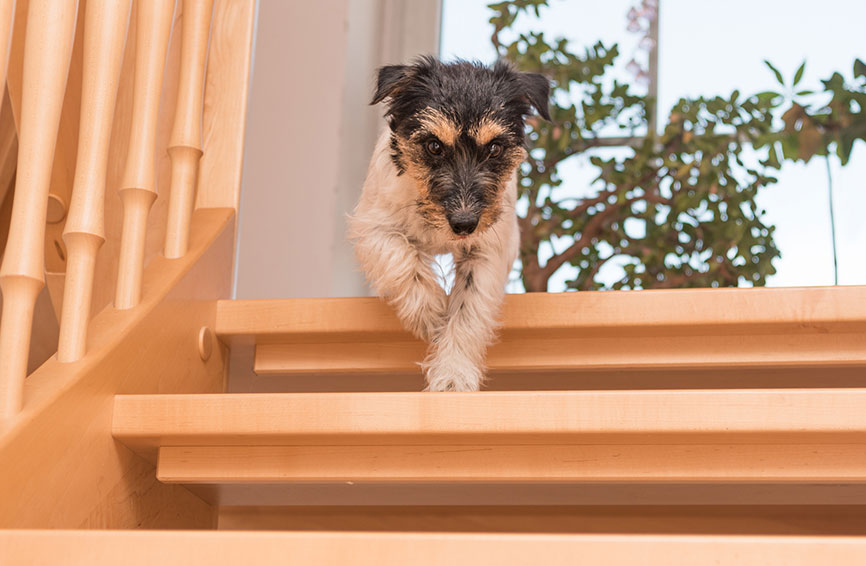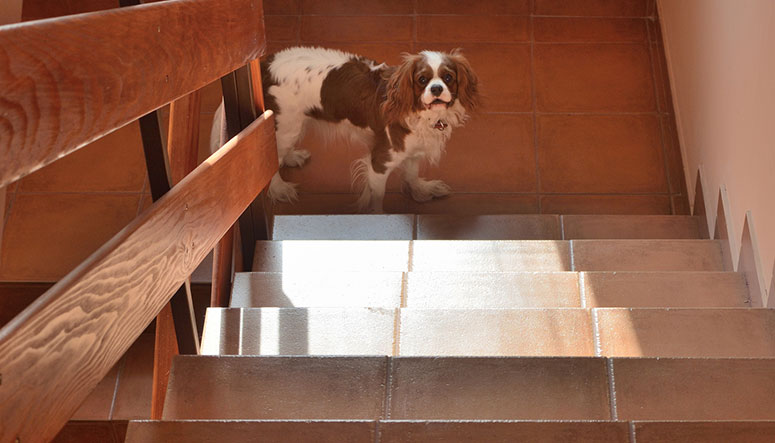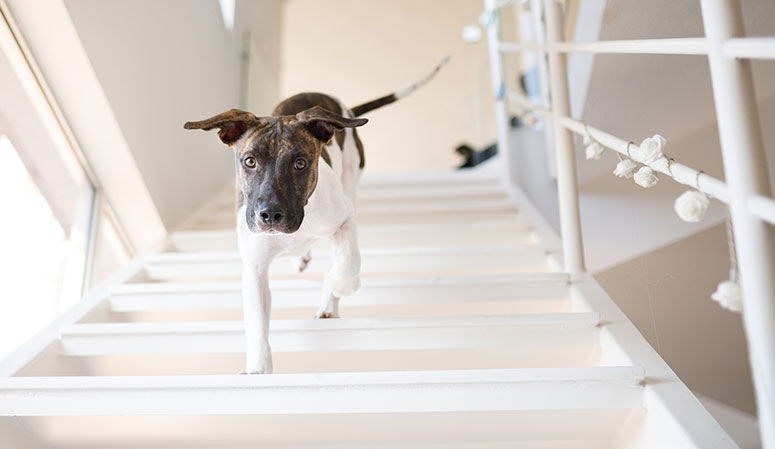Key Takeaways
- While some dogs are natural and comfortable going up and down stairs, others may need some training.
- First, make sure the stairs are safe and make some adjustments if needed.
- Take the training slowly, and always use positive reinforcement with your dog. Don’t push them if they are too fearful.
Table of Contents
If you live in a house with stairs or visit places frequently with multiple stories, it may take a little work to ensure your dog is comfortable and safe going up and down steps.
Dogs are naturally cautious regarding heights, and most will have no problem learning to use stairs, especially since they probably want to follow their pet parents and explore other parts of the house. Still, for dogs with a fear of stairs or those with physical limitations, you may have to help them master the skill.
For some dogs, standing at the top of the stairs and looking down is daunting, like standing at the top of a cliff that you need to repel down. The steeper the stairs, the scarier the climb down. Remember that dogs have four legs, which makes the steps much harder to navigate.
A dog afraid of stairs may be unable to access certain parts of the house or places you visit. Fortunately, it’s possible to teach healthy dogs to use stairs safely. And there are some actions you can take to ensure any stairs in your house are safe for people and dogs.
Stairs can present a risk of injury
Even if your dog is comfortable on stairs, don’t encourage or allow them to run up or down the stairs. Even athletic dogs are at risk of injury, which could include a ligament tear that requires expensive surgery to correct.
“Stair-related injuries can range from muscle strains and bruises to fractures, head injuries, and even death,” says Dr. Courtney Arnoldy, founder of the Small Animal Rehabilitation Program at the University of Wisconsin Veterinary Care.
Puppies, senior dogs, and those with long spines (like dachshunds, basset hounds, and Corgis) are especially susceptible to injuries when navigating stairs. Miniature or small dogs like Chihuahuas may also have trouble hurdling a big step. When first introduced to stairs, some dogs may be anxious, while others may enthusiastically run up or down them but fall and get hurt.
Some dogs with medical conditions will have trouble going down stairs but no hesitation going up and vice versa. For example, pups with orthopedic conditions – including hips, knees, and hind legs – may struggle or hesitate to go up, but going down is not a problem. On the other hand, dogs with elbow or shoulder problems may experience pain while going down but not up, said Dr. Jonathan Wood, staff clinician in neurology at the University of Pennsylvania School of Veterinary Medicine.
Ensure your stairs are safe
Very steep or narrow stairs, such as those leading up to an attic or basement, are unsafe for dogs and should be avoided. And only attempt stairs with your dog if there is a railing or barrier on both sides. Ensure the steps are not slippery, with no sharp edges or objects that could cut a paw.
Typical stairs – wider and less steep – can be made safer with a few changes. Carpeted stairs are going to be the easiest for your dog to navigate. They won’t slip easily and can gain traction.
You can also make some adjustments to the stairs that might help your dog:
- Install some lighting: If your stairs are dark, adding light will give your dog confidence and help them navigate.
- Use stair runners. If your stairs are hardwood, stone, or tile, adding a runner covering all the steps or individual pieces of carpet with a sticky back on each step will give your dog better purchase and cushion them if they should slip.
- Install a ramp. While a ramp is not practical for a long set of stairs, it can be helpful if just a few steps create a problem for your dog. Just like stairs, your pup may need some training and practice to navigate a ramp. Ensure that the ramp has good traction, is wide enough, and is extended as far as possible to give a gentle slope to navigate.
The paw pads on older dogs can become hard and less supple, which gives them trouble with slippery surfaces. Applying a wax or lotion designed for dogs’ paws can help. You can also try grips or booties for your pup’s feet which will help with stairs and other slick surfaces. Most dogs do not enjoy wearing anything on their feet, but most can learn to tolerate them.
Here are some tips on how to teach your dog to be comfortable with stairs:
Introduce the stairs gradually
Start by introducing your dog to the bottom step of the staircase. Allow your dog to sniff and investigate the step at their own pace and offer them treats and praise as they take a step. You can also put a treat on the next step to encourage them to move forward. Gradually move up to the next step and repeat the process.
Stay close behind your pooch to put them at ease and catch them if they stumble.
Teaching a dog to be comfortable with stairs takes time and patience. Do not rush the process; allow your dog to move at their own pace. If your dog becomes anxious or scared, take a break, and try again later.
How to tell if your dog is feeling anxious or scared
Dogs may start panting, licking their lips, yawning, or appearing fidgety when they are nervous. Signs of fear are ears pinned back, a tucked tail, crouching low to the ground, running away, and freezing in place. In cases of extreme fear, their whole body could shake. It’s critical to stop training before their anxiety increases to intense fear.
If your dog is fearful, encourage them to approach the stairs. Sit on the ground near the stairs and call them to you; if they come, reward them with a high-value treat. Repeat this until your dog easily approaches you as you sit at the bottom of the stairs. Once they are comfortable, you can start encouraging your dog to use the stairs.
Be encouraging
Dogs respond well to positive reinforcement, so reward your dog with treats and praise every time they progress, such as taking a step up or down the stairs. Make a big fuss and double down on the rewards once they reach the top or bottom. If you have a friend or family member available that your dog loves, you can position them a couple of steps above them on the stairs, holding a yummy treat as additional encouragement. After your pup builds their confidence, your helper can stand at the top or bottom of the stairs for extra motivation. Never punish your dog for not progressing, as it will make them more anxious and weaken your bond.
Remember, your energy and emotions affect your dog’s comfort level and self-confidence. Stay calm and grounded, which will help your dog feel emotionally supported by you. Have a patient, relaxed attitude, and don’t focus on making progress; instead, ensure that you are always kind and encouraging without putting any pressure on your pup. First and foremost, the goal is to create a feeling of safety for your pooch as you help them learn and gain confidence in themselves. By taking this gentle training approach, you are building greater trust in your relationship and setting them up for success in future situations they may struggle with.
Use a leash and harness or sling
If your dog hesitates to climb the stairs, try using a leash and harness to guide them up or down. For some dogs, this will give them a sense of security and help them feel more comfortable, and you can give them gentle encouragement if they are struggling. While other dogs may feel more afraid and trapped being on a leash, so pay careful attention to their body language to determine if a leash is helpful. It’s also important to never pull on the leash if they resist, as this is their way of communicating that they are afraid. Another method is to place a sling (a large towel or blanket) under the belly or chest to guide your dog. Always ensure that your dog’s feet are touching the ground when using a sling, or it will create more fear.
Practice regularly
Practice regularly with your dog to help them become more confident with the stairs. Set aside about five minutes twice a day to practice when the house is quiet and calm, and no one is using the stairs. This will help reinforce a positive experience and create a comfortable association for your dog. It’s always best to do a short training session when a dog exhibits fear and insecurity, as it takes a lot of energy and courage as they attempt to overcome their anxiety. Ending on a good note is always best, so don’t pressure them to learn; just take it slow and let their reaction guide you in knowing when to move to the next step.
What to do If your dog cannot use the stairs
If all else fails, and your dog cannot navigate stairs due to fear or physical limitations, consider carrying them up and down stairs if they are small enough and you are strong enough to handle them.
For bigger dogs who you can’t carry up and down, it’s best to avoid the stairs when possible. Make sure to locate everything your dog needs and enjoys on the main floor of your house. Block off the stairs when you’re not home or when you will be on a different floor than your dog for some time. For most dogs, using a baby gate works well to block access.
Teaching a dog to be comfortable with stairs takes patience, consistency, and positive reinforcement. With these tips and a little practice, most dogs can become confident navigating the stairs in your home. If you are unsuccessful after several tries, don’t force it, and make adjustments so your dog doesn’t need to use stairs.












